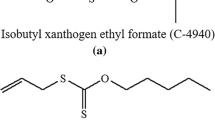Conclusions
-
1.
Sorption of xanthate on sulfide minerals depends on the surface charge. Chalcopyrite, cosalite, and activated sphalerite exhibit two xanthate sorption maxima in the range of positive values of the surface charge, owing to the presence of binary salts.
Maximum sorption of the collector on metallic and native bismuth is observerved at markedly different potentials (at −25 and +50 mV, respectively).
-
2.
Detachment of air bubbles and a toluene drop from mineral surfaces takes place during cathodic polarization. The value of the polarization potential necessary for removal of the air bubble (toluene drop) depends on the amount of collector and the nature of the mineral. An air bubble is not detached from the surface of sphalerite, even at high polarization potentials (\t-1900 mV), owing to the absence of a change in the state of the absorption layer.
-
3.
The difference between the maximum xanthate sorption potentials for bismuthinite (+175 mV) and chalcopyrite (+225 mV) and the presence of a wide range of increased sorption potentials for cosalite (200\2-250 mV) should be utilized for selective separation of these minerals.
Similar content being viewed by others
Literature Cited
I. N. Plaksin and R. Sh. Shafeev, “Effect of chemical nonuniformity on the surfaces of sulfide minerals on xanthate distribution under flotation conditions, Dokl. Akad. Nauk SSSR,121, No. 1 (1958).
I. N. Plaskin and R. Sh. Shafeev, “On the mechanism of formation of electrochemical nonuniformity of sulfide minerals,” Dokl. Akad. Nauk SSSR,125, No. 3 (1959).
R. Sh. Shafeev, “Some characteristics of flotation properties of sulfide minerals,” Nauchn. Soobshch. In-ta Gornogo Dela, No. 10 (1961).
A. N. Zhdanova, “Electrochemical study of processes on the surfaces of crystals of heavy-metal sulfides,” ZhFKh,28, No. 5 (1954).
V. A. Kremer, Electrical Properties of Surfaces and Their Importance for Flotation, Nauchn. Tr. Khar'kovskogo Gorn. In-ta, Vol. 3 (1956).
S. G. Salamy, The Application of Electrochemical Methods to Problems in Flotation, Ph.D Thesis, University of Melbourne (1952).
R. Tolun and Y. A. Kitchener, “Electrochemical study of the galenaxanthate-oxygen flotation system,” Bull. Inst. Min. and Met., No. 687 (1964).
A. A. Abramov, “Electrochemical measurements in the study of the surfaces of minerals and solutions,” Obogashchenie Rud, No. 4 (1965).
A. A. Abramov, “Effect of solution alkalinity on the surface state of chalcopyrite,” Obogashchenie Rud, No. 6 (1965).
A. A. Abramov, “The products of oxidation of galena in distilled water,” Obogaschenie Rud, No. 1 (1966).
A. A. Abramov, “Character of attachment of butyl xanthate and dixanthogenide and the flotability of chalcopyrite,” Obogaschenie Rud, No. 4 (1966).
A. A. Abramov, “Sorption of laurylamine during flotation of chalcopyrite,” Obogaschenie Rud, No. 6 (1966).
A. A. Abramov “Mechanism of the effect of xanthate and xanthogenide during flotation of pyrite,” Tsvetnye Metally, No. 10 (1966).
A. A. Abramov, “Causes of the depressant effect of sodium sulfide on pyrite flotation,” Tsvetnye Metally, No. 3 (1967).
M. Ya. Ryskin and S. I. Mitrofanov, “Study of electrocapillary phenomena at the boundary between a mineral and a xanthate solution,” Izv. Akad. Nauk TadzhSSR, Otd. Fiz.-Tekhn. i Khim. Nauk, No. 1, (19) (1966).
S. M. Yasyukevich and S. A. Tikhonov, “A method for measuring potentials on minerals,” Tsvetnye Metally, No. 6 (1957).
M. Ya. Ryskin, Study of the Electrochemical Properties of Sulfide Minerals during Reactions with Certain Reagents, Author's Abstract, Moscow (1965).
R. Sh. Shafeev, “Use of radioactive isotopes for studying the interrelation of the semiconductive properties of the surfaces of sulfide minerals and attachment of xanthate,” Papers of the Second Leningrad Conference on the Use of Radioactive Isotopes in the Coal and Ore Industries, Summaries of Reports [in Russian], Vol. 1, Moscow-Leningrad (1962).
V. V. Skorchelleti, Theoretical Electrochemistry [in Russian], Goskhimizdat, Moscow (1959).
A. N. Frumkin, V. S. Bagotskii, Z. A. Iofa, and B. N. Kabanov, Kinetics of Electrode Processes [in Russian], Izd. MGU, Moscow (1952).
V. A. Glembotskii, E. S. Sokolov, and P. M. Solozhenkin, “The flotabilities of bismuth minerals,” Dokl. Akad. Nauk TadzhSSR, No. 4 (1966).
Additional information
Institute of Chemistry, Academy of Sciences of the TadzhSSR, Dushanbe. Translated from Fiziko-Tekhnicheskie Problemy Razrabotki Poleznykh Iskopaemykh, No. 1, pp. 104–110, January–February, 1969.
Rights and permissions
About this article
Cite this article
Solozhenkin, P.M., Sokolov, E.S. & Kopitsya, N.I. Influence of the surface charge of sulfide minerals on sorption of the collector and the change in the contact angle. Soviet Mining Science 5, 81–85 (1969). https://doi.org/10.1007/BF02501714
Received:
Issue Date:
DOI: https://doi.org/10.1007/BF02501714



